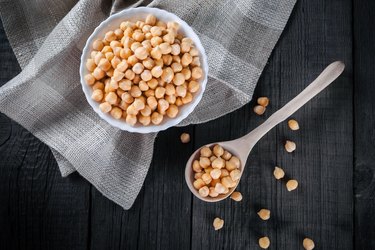
Chickpeas, also known as garbanzo beans, can be eaten whole or mashed. They are often used in foods like hummus or chickpea salad. These legumes are tasty and filling, but canned varieties often contain a lot of sugar and salt.
Are Canned Chickpeas Safe?
Video of the Day
Packing and shipping products across the world allow you to try foods that may not be available in your area. There are many ways to keep food fresh while shipping, such as refrigerating them or adding preservatives. Canning is an option too.
Video of the Day
Large food companies handle the canning process in factories, but this is something you can also do at home. However, it's not a perfect method of preservation because it can change the taste and quality of food over time.
An article from the University of Minnesota explains that metal cans or lids can rust, allowing spoilage agents to leak into food. Light and high temperatures may affect the quality and nutritional content of canned foods too.
The same source recommends eating canned products within one to three years of the date on the package, depending on the type of food. Canned fruit juices, for example, should be stored for no longer than a year. After that point, you should discard them. The food may still be edible after that date, but its flavor and nutritional value might not be the same.
Perhaps the greatest danger of eating canned foods is botulism. Normally, botulism isn't a real concern for most people. According to the Centers for Disease Control and Prevention (CDC), it's a very rare but serious illness caused by bacteria that attack the nervous system. Improperly canned foods, particularly those canned at home, pose the greatest risk.
The bacteria that cause botulism tend to grow and multiply in low-salt, low-oxygen and low-sugar environments, states the CDC. Adding sodium or sugar to canned chickpeas can ward off pathogens, but it also raises some health concerns for people who are trying to limit their sodium or sugar intake.
Canned Chickpeas Nutrition Facts
Chickpeas are a well-balanced food because they contain protein, carbohydrates and fat. A December 2016 review published in Nutrients notes that most Americans don't eat enough vegetables per day.
As the researchers point out, legumes, in particular, are lacking in the American diet. Although two of them received funding from a private organization, they had no role in the design of the study, so their findings are accurate.
The number of calories in a cup of canned chickpeas, which includes both liquids and solids, is 211 according to the USDA. There are also 12 grams of protein, nearly 5 grams of fat and 32 grams of carbs. According to the USDA's canned chickpeas nutrition facts, one cup provides about 11 grams of fiber.
Chickpeas, which are legumes, contain vitamins A, C and E. They also supply fiber and minerals, such as potassium and iron. According to the Nutrients review, these legumes have been shown to lower some markers of cardiovascular disease and regulate blood sugar and insulin. Altogether, chickpeas are a healthy food and have their role in a balanced diet.
One nutrient included in most canned foods is sodium. There are about 1,250 milligrams of sodium in each can of chickpeas, depending on the brand. Your daily intake should be approximately 1,500 milligrams, according to the American Heart Association. However, a more realistic goal is 2,300 milligrams per day.
Health Dangers of Canned Chickpeas
One can of chickpeas puts you at or near your daily limit of sodium, and you're probably consuming this nutrient throughout your day in other meals too. The CDC explains that eating too much sodium may increase your risk of developing high blood pressure, which may contribute to heart disease and stroke.
Some canned chickpea brands contain added sugar as a preservative. The average American is already eating too much sugar, according to the CDC, so it's helpful to cut any excess out of your diet. The sugar in food increases its calorie count but doesn't add nutrients other than carbs.
When consumed in excess, sugar may elevate your risk for type II diabetes, obesity and heart disease. A can of low-sodium chickpeas boasts 11.7 grams of sugar, which isn't as much as in soda or candies, but it does add to your daily intake. Since sugar can be dangerous for your health, it's best to check the nutrition label of canned chickpeas and pick a healthier option if possible.
- U.S. Department of Agriculture: Chickpeas, Canned, Low Sodium, Fat Not Added in Cooking"
- Centers for Disease Control and Prevention: "Know Your Limit for Added Sugars"
- American Heart Association: "How Much Sodium Should I Eat per Day?"
- U.S. Department of Agriculture: "Chickpeas (Garbanzo Beans, Bengal Gram), Mature Seeds, Canned, Solids and Liquids"
- Nutrients: "The Nutritional Value and Health Benefits of Chickpeas and Hummus"
- Centers for Disease Control and Prevention: "About Botulism"
- University of Minnesota Extension: "Storing Canned Food"